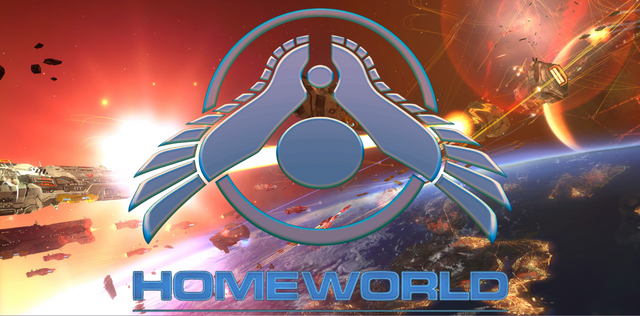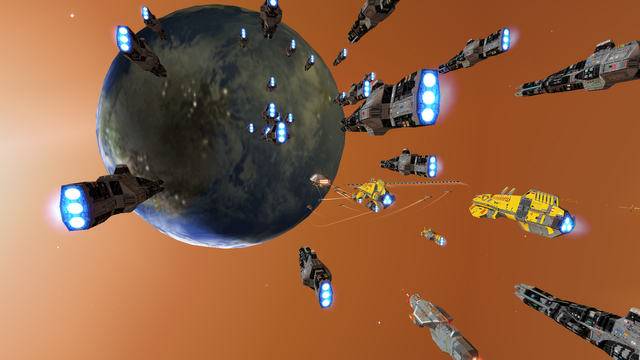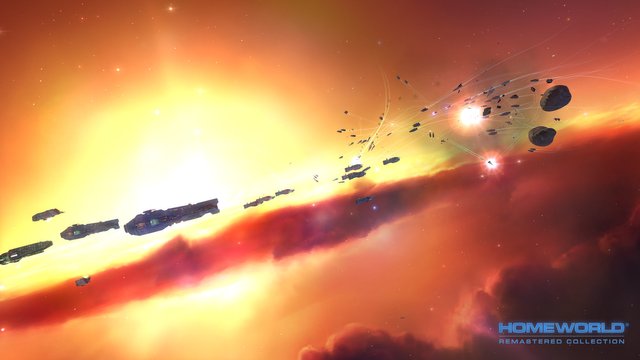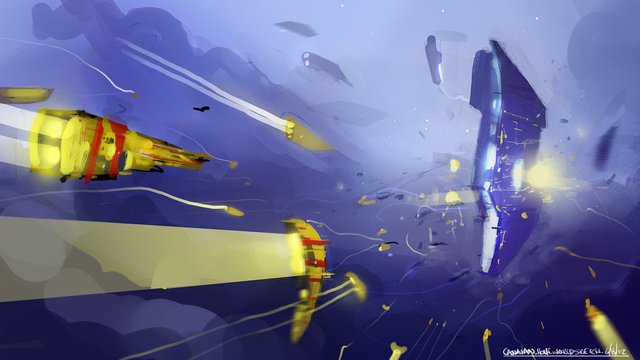Homeworld - a blast from the past

Homeworld is a real-time strategy (RTS) game created by Relic Entertainment and published by Sierra Studios after a two year development period on the 28th of September, 1999 for PC. It was one of the first fully 3D strategy games that also employed movement on all axes. The game featured outstanding graphics and a great exploration and discovery themed story following an underdog space-faring race.
Development
The development studio, Relic Entertainment, was was initially founded in Vancouver, Canada on the 1st of June, 1997. They swiftly began work on their first title, the subject of this review. The company's founders, Alex Garden, who served as the game's director, and Luke Moloney, whe was the lead developer, pitched the game to Sierra Studios using only two whiteboard presentations and no prototype or demo. Somehow they managed to sell it, even though they did not set out to create a specific game, but rather a tool to portray large space battles and built the game around that. In fact, Garden stated in an interview with Computer Games Magazine in 1998 that "there's no sort of design philosophy behind it. The fact that it's real-time strategy was almost a fluke".
In any case, to achieve their vision, they took inspiration from the original Star Wars trilogy, as well as the 1970s incarnation of the Battlestar: Galactica TV series, Garden saying that the original concept was "a 3D game that looked like you were watching Star Wars but had a storyline like Battlestar Galactica", in an interview with PC Zone. Thus, the game ended up as an RTS, because he felt that placing the player in the cockpit of a shit, like in Star Wars: X-Wing vs. TIE Fighter, would detract from the overall large-scale battle, thus electing to place the player in control of the fleet, rather than a craft within that fleet.
Thus, the main systems for controlling the units were done about eight months prior to release, as well as high quality models of the spacecraft. In the months leading to said release, the team focused on tweaking the systems and and the game's AI to do intricate maneuvers such as the Immelmann turn to aid with immersion. The trails left by the craft in the original vision for the game, led to the team referring to it as Spaghetti Ball for its working title. Initially, the game was supposed to launch by the end of 1998, and the team claimed that if they had known how difficult it was to implement their vision, they might not have gone through with the project. Personally, I'm glad they did take it on, even if customisation options and convoy routes or differing unites for the games factions were cut out of the final product.
Plot
Spoiler warning! This paragraph will contain spoilers, so you might want to skip it if you have not played the game. The story is great, and I highly suggest you experience it for yourself.
The game follows a humanoid species that inhabit the desert planet of Kharak, known as the Kushan. A hand drawn, black and white cutscene starts off the game, such narration being employed between every campaign missions. It informs the player of the recent history of the Kushani people that had discovered a spaceship buried on the surface of the planet. Inside, a tablet containing a starmap with their planet at one end and another at the other. This latter planet was labeled Hiigara, meaning "home". In light of this discovery, the different tribes unite to build a giant ship to take 600,000 people through space in order to discover their origins.
An neuroscientist and overseer of this massive project, Karan S'jet is embedded into this mothership (pictured above) in order to control the fleet, to replace an unsustainably large crew. In the next mission, the player jumps to a nearby system to test out the craft's different tools, this serving as a tutorial. However the support ship that was to meet them there is found destroyed, only a small squadron of unknown enemy fighters remaining. Next, they retreat back to Kharak, but find it burning with only those 600,000 explorers still alive in their cryogenic pods, but under attack. This whole mission takes place to the tune of a 1936 orchestral arrangement of Samuel Barber's Adagio for Strings, thus cementing it as the de facto center piece of the game's soundtrack. You can listen to it below, or here, as it was originally written for a quartet.
After capturing an enemy frigate and questioning its captain, who did not survive interrogation, the player learns that the Kushan had broken a 4,000 year old treaty forbidding them from developing hyperspace technology, thus extermination of their planet was the consequence. Thus, the crippled civilisation sets of for Hiigara to learn of their past and this treaty that exiled them to this planet, and confront the Taiidan empire that rule the galaxy. Right after fleeing their dieing planet, they meet a friendly trader species, known as the Bentusi that aids the player with powerful technology and informs him of a prophecy involving the faction he is controlling.
This massive trek takes the player through asteroid fields, nebulas, ship graveyards and Taiidani outposts. On their way, they encounter mercenaries, confront an isolated offshoot of their species that retreated within a nebula, give asylum to a Taiidani rebel captain Elson, and save the Bentusi, who are under attack for aiding you. For this, they promise to summon the Galactic Council to discuss the Kushani people's claim to their homeworld. After a long trek, a final assault and a massive space battle, they can claim the lush planet as their own, Karan being the last to leave the mothership.
Gameplay
Homeworld plays very similarly to a standard RTS game. The player controls a fleet, with the mothership serving as the central base, which during the campaign cannot move. Unlike most other craft, it can build ships ranging from small fighters and bombers, to corvettes that serve as military and support craft, to frigates that can repair allies and lay mines, to large destroyers and massive battleships and carriers that can support a small fleet of their own.
In order to build their fleet, players must gather resources found in asteroids, using harvester craft and possibly set up a mining operation with a larger craft that can serve as an outpost. During a battle (or the length of the campaign), research must be conducted in order to build new ship types, unlock different weapons and technology, as well as improving existing designs. This research takes time and costs resources, so the player must manage the economy carefully, especially in the campaign, where the fleet carries over between missions, and losing craft can be devastating as the enemy fleet does not scale with your own.
Movement is done in all three axes, and can be done directly in the game map, or using the sensors map, which include markers for resources and different types of ships, as well as displaying the central plane, making such orders more easily understandable. Small craft have an added layer of difficulty, as they consume fuel, and thus, must return to the mothership or a nearby carrier, support frigate, or a mining outpost in order to refuel and rearm. Battles take place on huge spherical maps and ships can be grouped and assigned different formations for different tactical needs.
Reception and Legacy
The game released to critical acclaim, most publications praising its breathtaking graphics, that for the most part, still hold up to this day. Others lauded the fully 3D environment and movement, setting it apart from other strategy games, displaying the full grandeur of space and possibly changing the genre forever. Others also praised the soundtrack, which fitted perfectly with the exploration of the vastness space -theme.
It sold over 500,000 copies in the first six months in the United States alone, and was highly regarded both by critics and users alike, gaining a Metacritic score of 8.9/100. It won several awards, including 1999's Game Critics Award, Best Original Story, Best Original Soundtrack, and nominated for multiple Game of the Year awards, among others. It ended the year as the highest rated game on PC and the fourth highest rated among all platforms.
This success spawned a game in the same universe by the name Homeworld: Cataclysm in the year 2000, that followed the Kiith Somtaaw, a Hiigaran clan, and its struggles to protect the homeworld from an unknown biological entity, known as The Beast fifteen years after the events of the original game. A full fledged sequel arrived in 2003 that took place a century after the first game's conclusion, in which the Hiigarans face off against a powerful raider faction, known as the Vaygr.
Financial problems hit some time after, and the intellectual property ended up in THQ's possession. This company ended up bankrupt, so the IP was picked up by Gearbox, who released a bundle that contained the classic versions of the original and its sequel as well as remastered versions of those games in 2015. One year later, a prequel was also released that focused on the strife between the tribes of Kharak as they vie for supremacy. This was called Homeworld: Deserts of Kharak, and it originally started life as a fan project that later received funding from the publisher.
Closing Thoughts
For me this is one of the best, if not the best space game I have ever played. I will forever cherish the experience the fully 3D space strategy game allowed me to enjoy. I was just a kid, that was stuck to my bed for a couple of weeks as I had broken my leg. That is when I lost myself playing this and marveling and the jaw-dropping graphics (at least for the time). The detailed gameplay and campaign, where losing a single ship could mean disaster, making you care for them, this feeling being emphasised by the unit chatter in the game.
They storyline, while not the most original, was told in an exquisite way, with lack and white, hand drawn cutscenes giving a documentary, or military log vibe, while those using the in-game engine would portray beautiful vistas and made one wonder of the vastness of space, as well as the humongous task ahead. I highly suggest you give this gem a try. But if you are still not satisfied, there are plenty of mods to take up your time, if you need something different, more complex, or incarnations of your favourite sci-fi universes, either in single player campaigns, or in multiplayer battles.
What are your thoughts? Have you played the game, original or remastered? What was your experience? Share below, along with any feedback you might have. It is greatly appreciated!
Thank you for reading, and keep on steemin'!
(clicking any image will take you to its source)




I have this game and played it a lot. Loved it :)
Indeed, really cool game :)
Love the HD remaster too, but I kinda dislike that the campaign now scales, kinda takes away from the feeling of being a small migrant fleet.
INTERESANTE
Loved how you could knock out subsystems with the bombers, like shooting the engines of inbound capital ships and moving the battle away from their guns and support.. Good stuff.
This was not the case for the first game. This was added in Homeworld 2, and was one of the better addition to give depth to the tactical options available. Unfortunately, the story was not as good and the enemies scaled with your strength, making decisions feel inconsequential. Still a great game, just not legendary like this one, which was way ahead of its time :)
Oh it didn't in the first? I stand corrected then, been some time ago since I played the first one :-), loved the standalone expansion too; cataclysm.
No worries, not sure if they added that to the remastered version, so maybe it is true for that; thus we may both be right :)
An yeah, Cataclysm was awesome, there's a rerelease on gog.com. You can buy it here. Much better than the sequel in my opinion. Totally disappointed Gearbox didn't iclude it in the remaster.